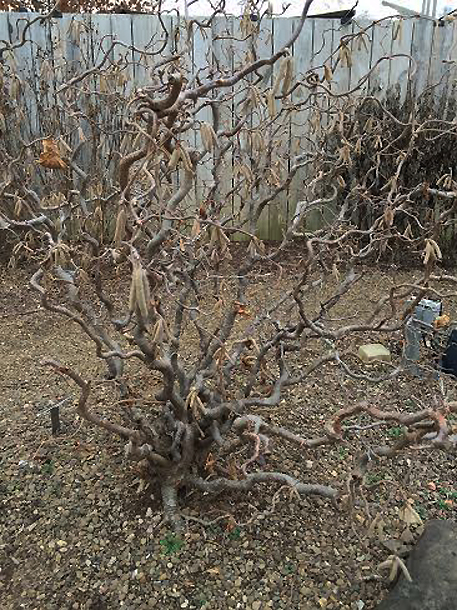Resource Library
Plant of the Week: Harry Lauder's Walkingstick
The distorted stems of Harry Lauder’s Walking stick make it an interesting wintertime specimen. (Image courtesy Gerald Klingaman)
Download High Resolution
FAYETTEVILLE, Ark. -- Fame is such a fleeting thing. In our garden grows a Harry Lauder’s Walking Stick (Corylus avellana ‘Contorta’), a widely grown and moderately popular deciduous shrub but few gardeners recognize its once-famous namesake.
Harry Lauder’s walking stick is an 8-foot-tall and wide deciduous shrub in the birch family that branches low forming a mass of tangled stems. It has randomly twisted and contorted gray-brown stems that can but seldom exceed an inch in diameter. The original species grows about 15 feet tall and is grown for its edible nut we call the filbert. It is one of the 10 species described with three native in the United States.
Leaves are rough textured, 3 inches long and almost wide and in the shape of an elongated oval with an acute point and coarse, doubly serrate margins. Leaves are colored medium green in the summer and a modest yellow-brown fall color. ‘Red Dragon’ and ‘Red Majestic’ are red leafed selections that have maroon foliage in the spring but tend to turn green in the heat of summer.
In winter the 2-inch long catkins are produced in pairs along the smaller twisted stems. Though self fruitful, Harry Lauder’s walking stick almost never produces nuts.
The contorted filbert was found growing in a hedgerow in the southeastern English community of Frocester about 1863. It was in the European garden trade 30 years after its discovery but didn’t seem to cause much attention in the United States until at least the 1950’s when several authors mention it but calling it “contorted filbert,” not by its more familiar name honoring Sir Harry Lauder.
Sir Harry Lauder (1870-1950) was a singer and comedian from Scotland who, in the years before WWI was perhaps the world’s most famous stage performer. He was the first performer to ever sell a million records and he performed widely in Europe and made more than 20 trips to the United States. He was knighted for his fundraising efforts on behalf of the war effort for WWI but also entertained troops in WWII. Part of his performance was to appear in kilts with a twisted and extravagantly distorted walking stick.
Harry Lauder’s Walking Stick and most other selections of filbert have been traditionally propagated by grafting so it was not uncommon to see normal stem growth protruding up through the foliage. In recent years “stooling” – a type of layering where sawdust is added around the base of plants that have been cut back severely in the spring – has gained prominence and reduced the suckering problem.
Contorted filbert and its red-leafed selections are hardy from zone 4 through 7 but they are more vigorous and easier to grow well on the cooler end of the growing zone. This shrub is fairly adaptable to soil conditions but grows best in rich bottomland soil that is well watered during the summer months. It should be planted near an entryway or patio as a specimen where the wintertime characteristics of the stem can be enjoyed. Prune as necessary to thin out and best display the twisted stems. Cut, dry stems are often seen in flower arrangements.
Jan. 30, 2015
